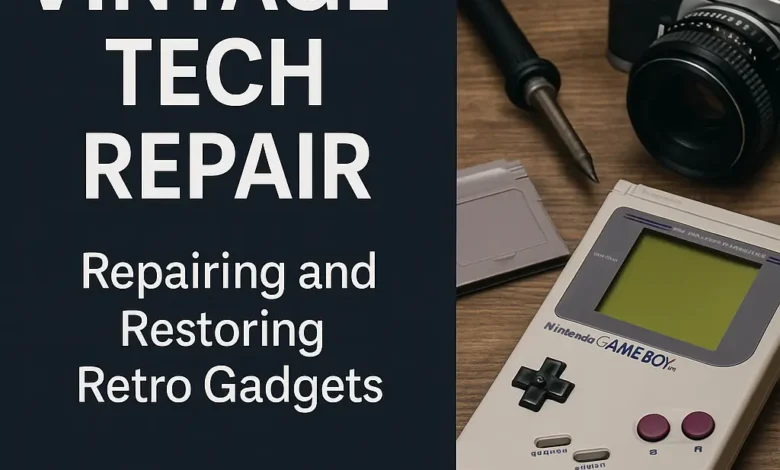
Vintage Tech Repair: Why Restoring Retro Gadgets Feels So Right
If you’ve ever blown dust off an old Game Boy or felt the satisfying click of a Walkman’s play button, you’re not alone. In 2025, vintage tech repair and Old electronics repair isn’t just a niche hobby—it’s a movement. From retro gadget restoration to fixing old electronics, the world is embracing the charm of the past with modern precision. Whether it’s a Game Boy restoration project on your weekend list or dusting off that old Analog camera repair, people everywhere are rediscovering the joy of bringing forgotten tech back to life. It’s more than Vintage tech repair—it’s revival.
Vintage tech repair: Why the Nostalgia Surge?
There’s something undeniably powerful about holding a piece of your childhood again. As digital fatigue grows, people are finding comfort in the tactile, the mechanical, the imperfect. Vintage tech repair have stories etched into their scratches, and unlike modern gadgets, they weren’t designed to be disposable.
Take Sarah, a 32-year-old graphic designer from Oregon. “Fixing my dad’s old Polaroid camera made me feel connected to him again,” she says. “It’s not just about functionality. It’s about memories.”
That emotional connection is what fuels the booming interest in retro gadget restoration. Old electronics Vintage tech repair Walkman or reviving a clunky flip phone brings a sense of purpose and satisfaction that even the sleekest smartphone can’t replicate.
Vintage tech repair: The Tools That Bring Tech Back to Life
If you’re new to old electronics repair, don’t be intimidated. You don’t need to be an engineer to get started—just a little curiosity and patience.
Here’s a basic toolkit every Retro gadget restoration should have:
- Precision Screwdrivers – For those tiny, stubborn screws in handhelds like the Game Boy.
- Soldering Iron – For reconnecting broken circuits or replacing components.
- Isopropyl Alcohol + Brushes – For cleaning corrosion or grime without damage.
- Multimeter – To test power, connections, and hunt down faults.
- Replacement Parts – Often sourced online, especially for analog camera repair or handheld consoles.
There are plenty of video tutorials, Reddit communities, and step-by-step guides for every skill level. Many enthusiasts even upload full teardown videos, allowing you to follow along as if you’re in a workshop together.
Game Boy Restoration: More Than Just a Trend
Let’s be real: the Game Boy wasn’t just a console—it was a rite of passage. Today, restoring one is almost a love letter to simpler times. A typical Game Boy restoration includes cleaning the motherboard, replacing worn-out buttons, and even upgrading the screen with modern backlighting.
And yet, despite these enhancements, the soul of the device remains. It still plays that satisfying “ping” when powered on. It still runs Tetris like a champion.
Enthusiasts often say that working on these devices is meditative. “You lose track of time,” says David, a retro gaming YouTuber. “I’ll sit down to fix one screen and suddenly, it’s 2 AM. But there’s nothing like the feeling when it powers on again.”
Analog Camera Repair: Capturing Time Again
There’s a growing group of creators who swear by film over filters. Analog cameras like the Canon AE-1 or Vintage tech repair Polaroids are back in style—and in demand. But as you might guess, they don’t age well without TLC.
Analog camera repair typically involves replacing light seals, cleaning internal mirrors, or fixing jammed shutters. The great thing? Most of these fixes are DIY-friendly. Online communities are eager to help, offering Vintage tech repair maps and sourcing guides for parts that are decades old.
One Reddit user shared how he learned to fix his grandfather’s Minolta only to photograph his own child’s birth with it. That’s the power of restoration—using the past to frame the present.
Vintage tech repair: Where to Find Vintage Tech Parts in 2025
Sourcing parts used to be the hardest part of vintage tech repair. But today, thanks to e-commerce and niche suppliers, it’s easier than ever.
Here’s where most restorers find gold:
- eBay – Ideal for donor devices and obscure parts.
- AliExpress – Great for bulk orders and custom shells (especially for Game Boy restoration).
- Retro-specific stores – Like Console5, iFixit, or dedicated analog camera parts shops.
- Reddit and Discord – Often, users swap or donate parts in the spirit of keeping vintage tech alive.
The hunt is part of the fun. It feels like modern treasure hunting—except instead of gold, you’re after a 1989 capacitor or a perfectly yellowed plastic shell.
Lessons from Restored Legends
Let’s spotlight a few restorations that really hit home:
- A college student documented his journey fixing a 1985 analog camera, capturing his entire semester on film.
- A gamer revived his childhood Game Boy Color and now runs a small business doing custom paint jobs.
- One tech blogger fixed an old tape recorder to play his late grandmother’s voice—recorded 30 years ago.
Each story reveals a pattern: people want to reconnect—not just with devices, but with the moments those devices hold.
And in doing so, they turn old electronics repair into something deeply meaningful.
Turning Passion into Income
Believe it or not, your passion for retro gadget restoration can pay off.
Here are a few monetization ideas:
- Affiliate blogs or YouTube channels – Review tools and link to them.
- Restoration services – Offer to fix devices locally or by mail.
- DIY kits – Curate and sell pre-packed restoration kits for beginners.
- Digital content – Sell tutorials, printables, or even Zoom Vintage tech repair coaching sessions.
As more people seek to bring their childhood tech back to life, trust and expertise become your greatest assets. The smaller the niche, the stronger the loyalty.
Repairing the Future by Embracing the Past
What began as a hobby is now a counterculture. Vintage tech repair represents something rare in today’s world: the belief that not everything needs to be thrown away.
When you restore vintage gadgets, you’re not just fixing something old. You’re preserving stories, memories, and a craftsmanship that’s increasingly hard to find.
So the next time you find a dusty gadget in the attic—don’t toss it. Plug it in, open it up, and see if you can bring it back to life. Because chances are, you’re not just fixing plastic and wires.
You’re restoring wonder.




